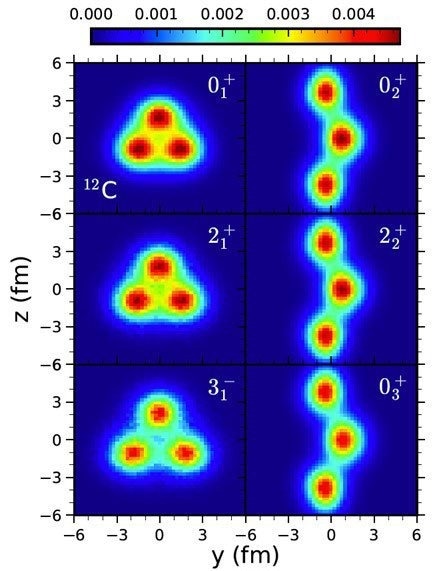The chemistry of organic matter and life depends on carbon atoms. Its most prevalent isotope, carbon-12, has incredibly intricate mechanics. The energy and underlying structures of the nuclear states of carbon-12 have been the subject of several experimental and theoretical studies.
 Nucleon densities for several low-lying states of carbon-12. Each image is labeled with the spin (0 to 3), the sign under parity inversion (+ or -), and the excitation number (1 to 3). Image Credit: Shihang Shen
Nucleon densities for several low-lying states of carbon-12. Each image is labeled with the spin (0 to 3), the sign under parity inversion (+ or -), and the excitation number (1 to 3). Image Credit: Shihang Shen
The most fundamental ideas in physics theory were used to compute these states in this work. The method calculated the three-dimensional shape generated by the protons and neutrons that make up the nucleus using nuclear lattice simulations and supercomputers.
The findings demonstrate that the six protons and six neutrons in each of the low-lying energy states of carbon-12 form a substructure that is responsible for the clustering of alpha particles. Helium-4 nuclei, which have two protons and two neutrons, are the source of alpha particles.
The Impact
The Hoyle state is one well-known nuclear state of carbon-12. The energy of this state is in close proximity to the threshold for three alpha particles or helium nuclei. Thus, this energy significantly increases the amount of carbon produced in stars that burn helium. This contributes to the explanation of carbon's existence in the universe.
The study's findings demonstrate that an obtuse triangle arrangement, or "bent arm," of alpha particles makes up the Hoyle state. Every carbon-12 low-lying energy state has an inherent shape made up of three alpha particles that can be either an obtuse or an equilateral triangle. The recently obtained results provide insights into potential nuclear state geometric configurations.
Summary
The foundation of the intricate organic chemistry that makes up the building blocks of life is the carbon atom. There is also a great deal of intricacy in the physics of the carbon nucleus in its main isotope, carbon-12.
The structure of the nuclear states of carbon-12 was calculated using the ab initio framework of nuclear lattice effective field theory by researchers from the University of Bonn, Forschungszentrum Jülich in Germany, Gaziantep Islamic Science and Technology University in Turkey, Tbilisi State University, Graduate School of China Academy of Engineering Physics, and the Facility for Rare Isotope Beams at Michigan State University.
The study discovered that the intrinsic shape of all low-lying states of carbon-12 is made up of three alpha clusters that combine to form an obtuse or equilateral triangle. In a mean-field picture, the states with the equilateral triangle form also have a dual description regarding particle-hole excitations.
The findings offer the first model-independent density map of carbon-12 nuclear states and are consistent with experimental evidence. The findings contribute to the understanding of how carbon originated from the helium and hydrogen that comprised the universe soon after the Big Bang.
The study was funded by the Deutsche Forschungsgemeinschaft (the German Research Foundation), the National Natural Science Foundation of China, the Chinese Academy of Sciences President’s International Fellowship Initiative, the National Security Academic Fund of China, Volkswagen Stiftung, the European Research Council, the Department of Energy, and the Nuclear Computational Low-Energy Initiative SciDAC-4 project, as well as computational resources provided by the Gauss Centre for Supercomputing e.V. and the Oak Ridge Leadership Computing Facility.
Journal Reference:
Shen, S., et al., (2023). Emergent geometry and duality in the carbon nucleus. Nature Communications. doi.org/10.1038/s41467-023-38391-y.